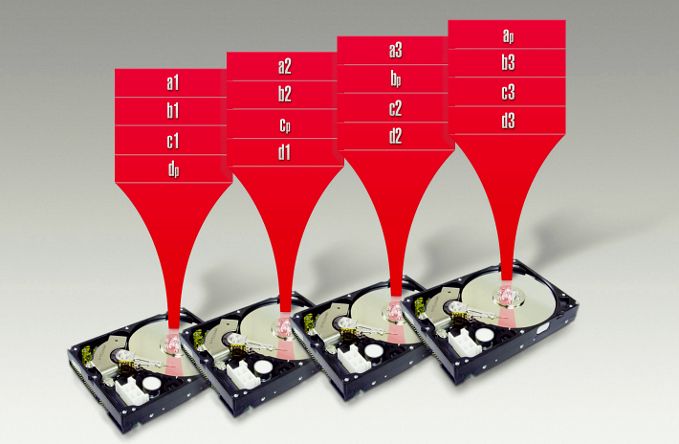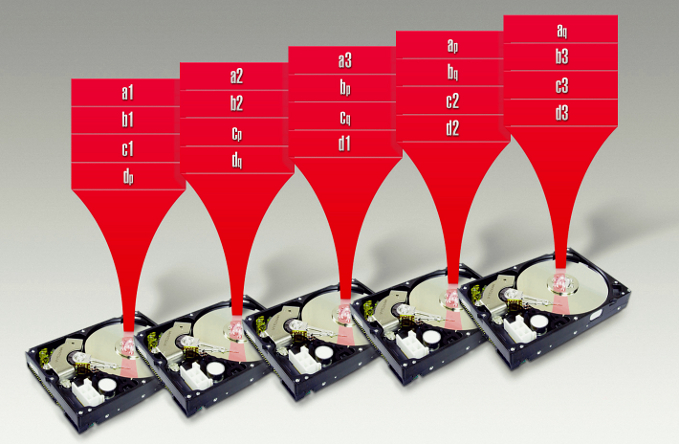RAID 5 RAID 6 Or other altErnativE?
Here we are with the next part of our RAID series. This time the article will concern RAID 5, RAID 6 and two alternatives – RAID 5E and 5EE. Take a look…
RAID 5
RAID 5 is one of the most popular implementations. It works almost the same as RAID 4 but with one difference. The parity bits are not recorded on a specifically prepared disk – they are dispersed throughout the matrix structure. What does this mean in the case of failure? Well, it is much easier to recover data (in case of failure of one disk). Also, the read speed is much higher (in comparison to RAID 0).
However, as usually happens, there are also some drawbacks. The necessity of calculating checksums causes a lower write speed. RAID 5 is also expensive in the case of the array reconstruction – if one of the disks have to be replaced after failure. Also read and write operations will slowdown in such case due to the need of calculating checksums.
RAID 5 is the best solution when we talk about data safety. In the case of failure the system will automatically rebuild the lost data so that they can be read (however, the current performance of the matrix will be reduced).

RAID 5
For more information about RAID 5 mode of action take a look here: “How does RAID 5 work? The Shortest and Easiest explanation ever!” by Janusz Bąk.
RAID 6. The next level of excellence and complexity
RAID 6 is sometimes called RAID 5+1. It is because its mechanism is based on RAID 5. Generally it is RAID 5 but array enriched with one additional disk. Thus it contains two independent checksums. It is more reliable, but its implementation is more expensive.

RAID 6
RAID 6 is resistant so much so that its work will be impossible only after the failure of at least three disks. What does it mean? One important thing: It is two times more resistant than RAID 5. What is more, the speed of the whole system is higher than in the case of a single disk. It makes RAID 6 an almost ideal solution (if we do not take into account the costs of implementation).
Enhanced RAID
RAID 5E
RAID 5E (Enhanced) works similar to RAID 5. It stripes data and parity across all of the drives in array. The main reason is a built-in spare drive. Thanks to that, RAID 5E offers good data protection and better throughput. Also read and write operations are more efficient in the case of RAID 5E. It is because of this that such actions proceed faster in the case of four physical disks rather than three with an idle hot spare.
If we take into account the advantages of RAID 5E – good data protection, large storage capacity and high performance (higher than in the case of RAID 5) – we may ask: why it is less used in practice? The response should be sought in relation to its disadvantages.
The main drawback of such a solution is that the spare drive cannot be a part of any other array. So, if there is a need to implement its functionality to another array, preparing another spare drive is the only way. The second thing is RAID 5E supports only one logical drive in one array. And the most important – the thing which makes RAID 5E a useless solution in most cases – it is firmware-specific. Not every kind of controller can support this RAID level (in contrast to i.e. RAID 5).
RAID 5EE – Hot Space
RAID 5EE is an extended version of RAID 5E. It stripes data and parity across all of the drives in the array but it has a more efficient distributed spare. Its rebuild time is also faster.
RAID 5EE provides good data protection – like in the case of RAID 5. It also increases throughput – by using an additional hot spare disk in the array. Thanks to that, in the case of failure, when we have to replace the failed drive, the data from the “Hot Spare” emergency area are automatically transferred to it (to the new drive). The exempt space is than raised as an emergency space.
In this case, the difference between RAID 5E and 5EE is that the RAID 5EE spare is interleaved with the parity blocks (it does not use contiguous free space for the spare).
RAID 5EE requires a minimum of four drives. Just like RAID 5E it is also firmware-specific. It means we can expect problems with a controller. Also implementation costs, and any other – i.e. in case of failure, can be high. So we can say that this option is similar to RAID 5E.
Other possibilities
As it is easy to imagine, there are many solutions based on RAID. We have presented only the basic possible implementations. Although it does not mean the end. We can still point toward: RAID 1E, RAID x0, RAID 6E, 6EE and other. If you want to read about any of them, just let us know. We will do our best to give you the information you need.





















Post a Comment